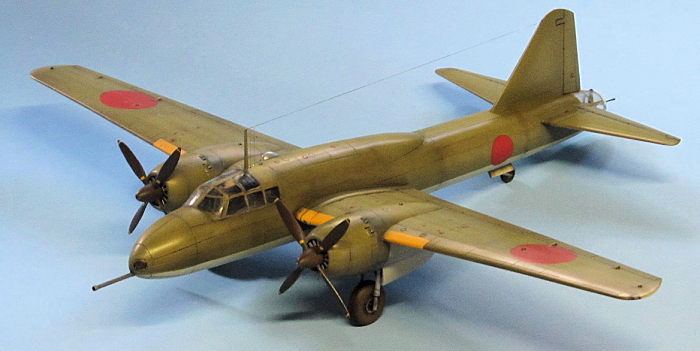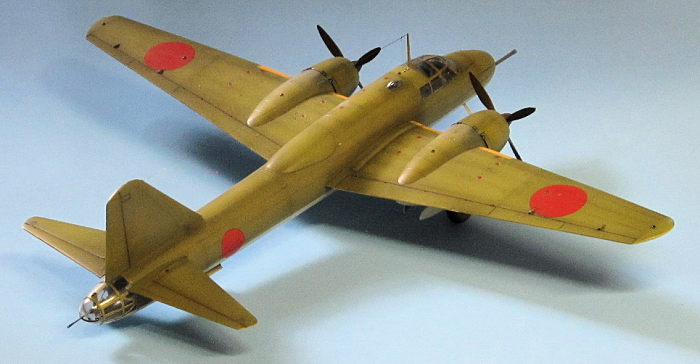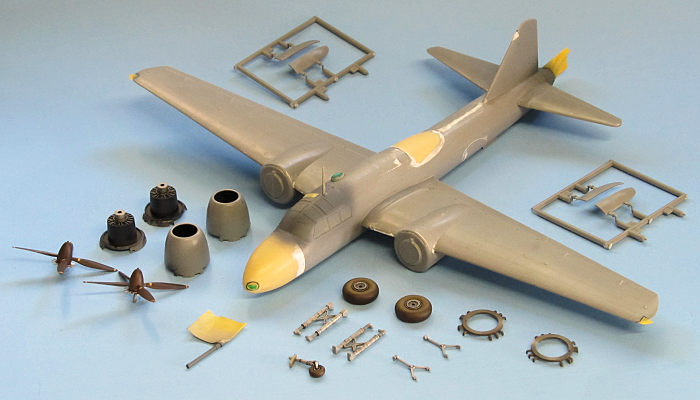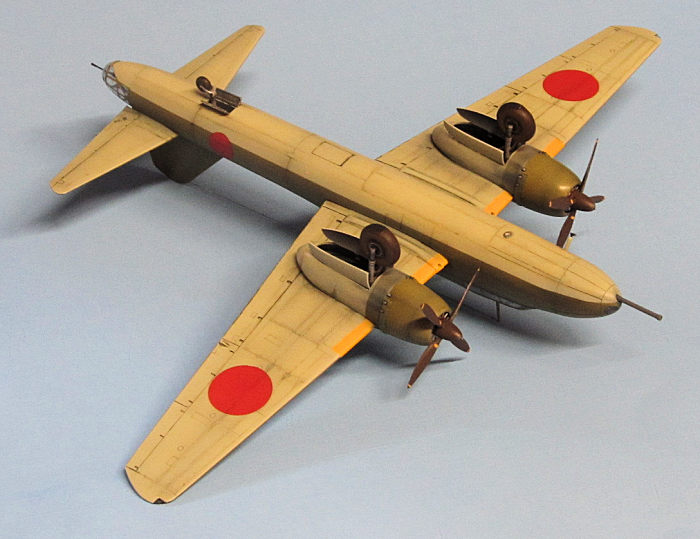
Hasegawa 1/72 Ki-109
| KIT #: | 00153 |
| PRICE: | $40.00 |
| DECALS: | Two options |
| REVIEWER: | Ryan Grosswiler |
| NOTES: | Ki-67 kit with resin, plastic, and metal conversion parts |

| HISTORY |
Despite the formal title of this kit, the Ki-109 was in fact a fully operational combat aircraft type. You wouldn't expect it to hold a notable place in WWII history, either, but it does.
If you're not familiar with the story of the base design, Mitsubishi's Ki-67 Hiryu bomber, it ran like this: in the unintended struggle to replace the very good but outdated Ki-21 "Sally" medium bomber, the Imperial Army had wasted precious time with Nakajima's underwhelming Ki-49 Donryu, only finally getting the high-performance medium bomber it had needed so badly in the form of Mitsubishi's counterpoint, the Ki-67. The prototypes of this aircraft were in fact so promising that the Imperial Army ended up blowing more time noodling around with the design and not freezing it for production until well into 1943.
It was natural that such a good, adaptable
aircraft design would be projected into a wide variety of developments for
different combat roles. As even in its bomber form it was exceptionally
maneuverable, it is no surprise that the only one of these proposals to see
the hardware stage was this, the Ki-109 heavy interceptor, envisioned to
counter the B-29 threat by carrying a cannon of no less than 75mm up to the
bombers' cruising altitude; the weapon not only packing enough wallop to
down the big bomber with one shot but also having an effective range to stay clear of its defensive
fire. The Ki-67's normally-aspirated Ha-104 engine was always seen as an
impediment to the aircraft being adapted to this role, and the new
supercharged version of this engine was supposed to be the key feature.
However, this development faltered, and it was decided to put the aircraft
into production with the standard engine just to get the type into service.
In partial compensation, the normal gunners' stations (except the one in the
tail) and all fittings and equipment related to the bomber role were
deleted.
one shot but also having an effective range to stay clear of its defensive
fire. The Ki-67's normally-aspirated Ha-104 engine was always seen as an
impediment to the aircraft being adapted to this role, and the new
supercharged version of this engine was supposed to be the key feature.
However, this development faltered, and it was decided to put the aircraft
into production with the standard engine just to get the type into service.
In partial compensation, the normal gunners' stations (except the one in the
tail) and all fittings and equipment related to the bomber role were
deleted.
Beyond that, there's really not much to tell. The twentyish production aircraft which rolled off the line between January and March of 1945 were delivered to two squadrons, reaching IOC shortly after another (more illustrious) lash-up, the Kawasaki Ki-100. On account of the fairly short heads-up time that the Japanese warning network could provide and the Ki-109's lethargic climb rate, the big fighter immediately had a difficult time being at the right place and right time to intercept the inbound B-29s. Throughout May and June of 1945 the Ki-109 squadrons were scrambled several times in attempted intercepts, but by late July it was decided to disband them and distribute the crew to other more productive units and equipment. The redundant aircraft sat about for the remaining weeks of the war, one or two being evaluated in an antishipping role for the anticipated Allied invasion.
Some scuttlebutt hints at maritime patrols over the Sea of Japan, others tell of one or two aerial victories over the intended target. None of my sources mention any of this, plus both Bueschell and Francillon are specific in stating that no combat success happened—though I've known their research, done mostly in the late '60s, to at times not be perfect. Did an IJAAF pilot, frustrated at his airplane's lack of climb performance, lob a round at a receding B-29 formation to score a chance kill? We are left to wonder.
| THE KIT |
 Prior, we had the nice 1960s kit from LS, released in both Ki-67 and dedicated
Ki-109 forms. Nice—except that it was quite undersized at about
1/76th scale...and for those who are really bothered by such things, retractable
landing gear, working flaps, and scribed hinomarus.
Prior, we had the nice 1960s kit from LS, released in both Ki-67 and dedicated
Ki-109 forms. Nice—except that it was quite undersized at about
1/76th scale...and for those who are really bothered by such things, retractable
landing gear, working flaps, and scribed hinomarus.
Just prior to the turn of this century Hasegawa corrected the situation with an all-new Ki-67 as the last installment of their late '90s Japanese Twins campaign. The base kit has been reviewed elsewhere on this site and is included here in its entirety, minus the main armament sprues. Per the specific subject, there are tan-colored resin parts for the gun nose and dorsal fairing, a white metal gun barrel, and two injected plastic parts to delete the waist gunner positions. Decal options cover the first prototype which retained all aft gun positions and a 'stripped' production aircraft. More on these later.
My sample was from the first batch; the store price tag dates it at hitting the shelf in December 2000. It must be a fairly popular variation of the base Ki-67 because Hasegawa has rereleased it at least twice since then with revised instructions, decals, and box art. Kit parts are the same.
| CONSTRUCTION |
You first choose between the prototype airframe with all aft gunners' positions in place, or a production example with most of these deleted. Either way, this project begins by committing to the Ki-109 with a 3/16" lateral cut from the front of the fuselage halves to accommodate the resin gun nose following guidance and drawings in the instructions.
Not mentioned in those instructions: don't forget to cut off the
protruding bit from the forward cockpit bulkhead (Part C13), too. While you're
at it, cut off the forward end of clear part J14 as well. Wanting to do a
definitive production example with all the mutations in place, I also installed
the waist opening covers at this time, parts K1 and K2. These were the n
filled, sanded, primed, sanded again, and the surrounding panel lines scribed
through the area: several of my references showed that these openings were
'skinned over' while still in the jigs for the production Ki-109 airframes.
n
filled, sanded, primed, sanded again, and the surrounding panel lines scribed
through the area: several of my references showed that these openings were
'skinned over' while still in the jigs for the production Ki-109 airframes.
A word of warning to the newish modeler: the rest of the construction sequence laid out in the Hasegawa instructions doesn't make much sense, as it has the builder adding the wings, engines, and lots of small parts before attaching the resin nose and dorsal fairing. Instead, add these two big resin parts after closing up the fuselage in Step 2, fill, sand, and scribe all the affected joints, then and only then move on to Step 3. Life will be much easier!
Hasegawa also instructs the builder to omit the left-hand pilot seat. I have no other documentation to support a single-pilot aircraft, but it seemed logical, given that all effort would have been made to save weight on the underpowered series aircraft. I sawed off the unrealistic mounting plinth for the seat as well, and scratch built some framing for the floor on the now-empty space following sketches in the Maru Mechanic book. Purely from promptings of rational imagination, I also gave the position a gunsight on the instrument panel visor, courtesy Quickboost's line.
Just because I'm incorrigible in this way and I really like the Hiryu in all its forms (except for the awful Sakura-dan suicide modification), a new pilot's canopy was vacuformed to get rid of the optical distortion in the stock parts. This thinner part also created more volume for me to rework the interior: namely, I mastered and cast in resin new cockpit seats/armor plate to replace the undersized ones (+/- 1/144th) provided in the kit. The tail gunner's position also received a bit of further detail following drawings and photographs in my references. The searchlight in the nose, represented only as a scribed oval, was drilled out, an MV Products lens installed, and a crash-molded clear cover glued in over that, which was later sanded flush and polished. While I was at my drill press, the hole for the 75mm cannon was sent a little deeper to better seat the main gun.
 Cockpit and other prep done; the rest of the project was more or less
straightforward assembly of dissimilar conversion parts. There are some slight
fit issues with the tail-gunner's cone (Part J11), in common with both the
standard and gun noses on the Ki-109 and Ki-67 kits, so I placed two 1/64" shims
between the extreme aft ends of the fuselage halves, which fixed the tail. Once
I had painted and weathered the spiffed-up interior, fuselage halves were closed
and the resin nose and dorsal fairing attached with J&B Weld—be sure to paint
the interior end of the resin nose black before attachment; you'll otherwise get
an annoying patch of tan-resin color visible through the canopy down in the
gunner's well!
Cockpit and other prep done; the rest of the project was more or less
straightforward assembly of dissimilar conversion parts. There are some slight
fit issues with the tail-gunner's cone (Part J11), in common with both the
standard and gun noses on the Ki-109 and Ki-67 kits, so I placed two 1/64" shims
between the extreme aft ends of the fuselage halves, which fixed the tail. Once
I had painted and weathered the spiffed-up interior, fuselage halves were closed
and the resin nose and dorsal fairing attached with J&B Weld—be sure to paint
the interior end of the resin nose black before attachment; you'll otherwise get
an annoying patch of tan-resin color visible through the canopy down in the
gunner's well!
Fit is only average for these resin parts; the nose seats well but doesn't quite match the contour of the fuselage it meets. Likewise, the dorsal fairing is slightly too short in depth. Both issues were dealt with using a pretty good amount of filler around their seams. The predictable procedure of sand/prime/sand then followed over a few reps. Take the time especially to eliminate the seam between the fuselage and the resin nose completely; there was no panel line there. On the other hand, the dorsal fairing has a rounded joint running around its perimeter. Such a long, curvy line would threaten to be the Scribing Job From Hell, but it was made quite easy with the discovery that Tamiya's flexible vinyl masking tape can also work well as a scribing guide as long as you use a very gentle touch. I took about ten minutes to lay this tape in place carefully and another five to do three passes with the back of my knife. Done.
A minor point: the instructions direct the builder to paint the cooling fans (part D11) a silver color. This is correct, but note that these fans have a short length of the spinner itself molded on to them. Take three minutes to paint these the same Propeller Brown as the prop and the rest of the spinner. This may seem like an extraordinarily minor point, but it makes a visible difference in how realistic the completed prop assembly looks in place. The canopy and tail gunner's position were masked, and general assembly followed. Small parts were added, the landing gear and wells masked, and it was off to the paint shop.
| COLORS & MARKINGS |
How badly I wanted to paint this model to match the kit's
stunning box art! However, all photographic evidence (as in the two or three
surviving photos which show a broadside view) indicates that the unit-issued
Ki-109 production airframes were delivered in simple olive-green over
green-gray, with plain
 hinomarus
in the usual six positions, and no other markings whatsoever besides those wing
leading edge yellow ID panels. The pictures of the aircraft with the cool
mottled camo? Those are all of the first prototype which retained the waist guns
and turret, and despite Hasegawa's instructions, the production aircraft did not
have the outlined national markings.
hinomarus
in the usual six positions, and no other markings whatsoever besides those wing
leading edge yellow ID panels. The pictures of the aircraft with the cool
mottled camo? Those are all of the first prototype which retained the waist guns
and turret, and despite Hasegawa's instructions, the production aircraft did not
have the outlined national markings.
As this therefore could make the large aircraft a very boring one, I spent some time with a layered, faded finish and threw about every special painting effect I could think of at it. Preshading, postshading, multihue, chipping, and marbling all got incorporated. The challenge here is to make it look subtle and not an example of the over-the-top "Spanish School" look. Did I succeed? Well, I guess that's a matter of subjective opinion....all this to depict an airplane left to sit and fade in the sun. No other weathering which would indicate a busily-working aircraft was applied, except just a hint of exhaust streaks starting to form over the half-dozen or so flights these airplanes likely made (factory test flight, delivery, and a few training sorties/attempted intercepts). Another seemingly minor point: when applying the wash, I was careful to depict the bomb bay doors not as an active opening but just another set of panel lines. Decals responded well to Micro Set but reacted badly to Micro Sol.
| CONCLUSIONS |
 For curious, new modelers who would like to venture into the world of multimedia
conversions, this product would be a great choice. It has all the interest and
pitfalls: the requisite multimedia elements, cuts into the kit plastic, average
fit, and a little guesswork...but all in such mild form that they don't really
threaten to turn the project into a catastrophe. Only a little elbow grease is
required to bring the project to accuracy.
For curious, new modelers who would like to venture into the world of multimedia
conversions, this product would be a great choice. It has all the interest and
pitfalls: the requisite multimedia elements, cuts into the kit plastic, average
fit, and a little guesswork...but all in such mild form that they don't really
threaten to turn the project into a catastrophe. Only a little elbow grease is
required to bring the project to accuracy.
For anyone, a great kit of this, the last Axis combat aircraft brought into frontline service.
| REFERENCES |
Bueschel, Richard. Ki-67/Ki-109 Hiryu in Japanese Army Air Force Service. Schiffer Military, 1997. ISBN 0-7643-0350-3
Mikesh, Robert. Japanese Aircraft Interiors 1940-1945. Monogram Aviation Publications, 2001. ISBN 978-0914144618
Author unstated. Maru Mechanic No. 32 Mitsubishi Heavy Bomber Type 4 (Ki-67). 1982
Recently-discovered photos posted on the Internet
16 October 2023 Copyright ModelingMadness.com. All rights
reserved. No reproduction in part or in whole without express permission from
the editor. If you would like your product reviewed fairly and fairly quickly, please contact the editor or see other details in the
Note to
Contributors. Back to the Main Page
Back to the Review
Index Page
Back to the Previews Index Page